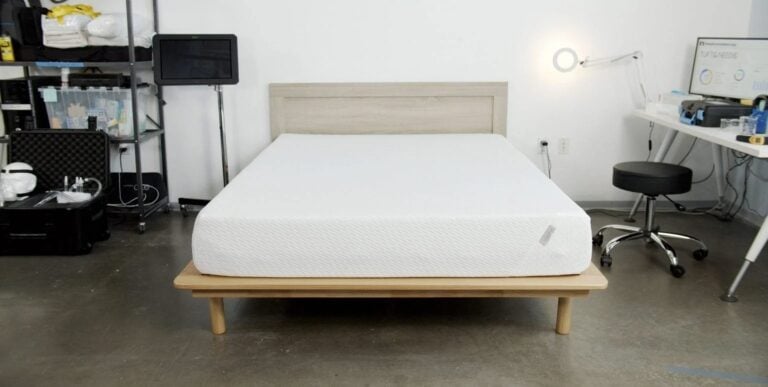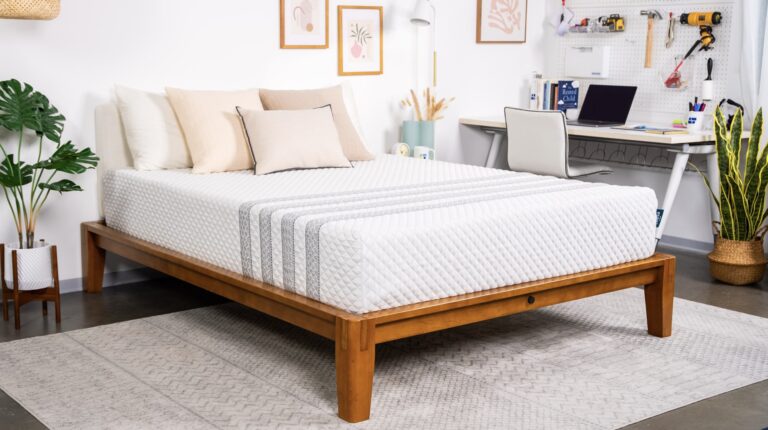When you buy through our links, we may earn a commission. Products or services may be offered by an affiliated entity. Learn more.
Leesa vs Tuft & Needle Mattress Comparison

Leesa Original
Bottom Line
The Leesa Original is an all-foam mattress that excels at pressure relief and motion isolation with just the right amount of bounce.
25% off sitewide
Full Mattress ReviewVS

Tuft & Needle Original
Bottom Line
The budget-friendly Tuft & Needle Original is built with breathable foams for a nice balance of cushioning, support, and breathability.
15% off mattresses
Full Mattress ReviewTuft & Needle released its flagship Original Mattress in 2012. This all-foam model has undergone several enhancements over the years, but the focus is still on offering a universally appealing mattress that won’t break the bank. The brand also sells several other mattress models along with bedding, bed frames, and sleep technology.
Leesa also originally launched with an all-foam mattress. The company now makes other styles including hybrids, latex hybrids, and a mattress for kids as well as another model designed for sleepers weighing up to 500 pounds. Leesa also sells bedding and bed frames.
Tuft & Needle and Leesa are both attractive options if you’re in the market for a new bed. We’ll examine the differences between the brands’ flagship all-foam models, reviewing how their materials and construction affect the way they feel. We’ll also take a brief look at shipping, warranty, and sleep trial policies so you can make an informed decision.
Quick Look
$1,059
$761
Medium (5)
Medium (5)
- Two foams, including memory foam, in comfort system
- Mixture of pressure relief and responsiveness
- Excellent motion isolation for couples
- Unique Adaptive Foam provides balance of contouring and bounce
- Quality temperature regulation for all-foam models
- Customer-friendly price point and sleep trial
- 120 nights (30-night requirement)
- Lifetime, limited
- 100 nights
- 10 year, limited
- A+
- A+
Our Testing Team’s Take
While mattress preference is subjective, we do our utmost to ensure our reviews are useful for a wide variety of people. Each mattress is thoroughly tested at our Testing Lab in Seattle, using an approach that combines both objective and subjective measures.
First, we run a series of tests involving pressure maps, heat sensors, and other instruments. By performing these same tests on every mattress, we can form a science-backed view of how each mattress performs compared to other similarly built models.
Next, we give the mattress to members of our testing team, which includes a variety of people with different sleeping preferences and body types. The testers perform everyday actions like changing positions and sitting on the edge of the bed to see how the mattress feels. Some of our testers also take the bed home to sleep on it for a longer period. To round out the data and help you find the best mattress, we also verify reviews from actual customers.
Our Verdict
There’s no clear winner when it comes to the Leesa vs. the Tuft & Needle. The flagship mattresses for each brand are similarly built and generally appeal to the same types of sleepers.
Leesa uses memory foam in the second layer, so you get the cushioning without the quicksand feeling. Tuft & Needle uses a proprietary foam designed to mimic memory foam in the top layer. The approach is different, but in both cases the result is a bed that cushions without an excessive hug.

Jeremy Klein
Senior Product Testing Manager
Side sleeper
160 lbs.
Nightly melatonin user
“The Leesa Original feels comfortable right off the bat. When lying on my side, I felt moderate contouring of my shoulders and hips, and I woke up without any aches or pains.”
As all-foam mattresses, the Leesa Original and the Tuft & Needle Original do a stellar job of molding to your body, helping to relieve pressure points and muffle your movements before they can wake up your sleeping partner. With a firmness on the softer side of average, both mattresses are well suited to side sleepers and people weighing up to 230 pounds.
Drawbacks include weaker edge support and some heat retention, although both companies use specially formulated foams to decrease heat retention compared with traditional memory foam.
Both brands also offer hybrid options, and Leesa has a range of specialized mattresses for specific groups like children or people weighing over 230 pounds.

Brad Nehring
Senior Product Analyst
Side sleeper
215 lbs.
Sleeps with a weighted blanket
“The Tuft & Needle Original is a little softer than I usually prefer, but the foam layers are fairly responsive and didn’t hug me too closely. There’s something really soothing about a mattress that conforms to your body like this one does.”
The Tuft & Needle Original is priced very competitively. Leesa offers a longer warranty and free shipping to all 50 states, but Tuft & Needle offers full refunds during the sleep trial while Leesa docks a nominal fee. If you’re unsure which mattress to choose, the sleep trial gives you ample time to try out the bed so you can get a feel for it before deciding if you want to keep it.
Construction and Materials
Both the Leesa and the Tuft & Needle are all-foam beds, featuring layers of softer foams over a firmer polyfoam support core.
| Construction Analysis | Leesa Original | Tuft & Needle Original |
|---|---|---|
| Cover | 87% polyester, 13% viscose | Micro polyamide and polyester blend |
| Comfort Layer | 2″ polyfoam | 1” polyfoam 1” poly foam |
| Transitional Layer | 2″ memory foam | 1” polyfoam |
| Support Core | 6″ polyfoam | 7” polyfoam |
Leesa Original Mattress Breakdown
For its flagship mattress Leesa has kept it simple, using a three-layer design that gets progressively denser as you move deeper into the bed. The Leesa Original Mattress has a grey knit polyester-viscose cover and a medium feel, equivalent to a 5 out of 10 on our firmness scale.
Under the cover is a 2-inch layer of polyfoam with moderate bounce. This foam is designed to breathe more than memory foam and prevent you from feeling uncomfortably warm as you sleep.
In the next layer are 2 inches of memory foam, a material known for its ability to adjust its shape in response to weight and pressure. This layer helps provide cushioning to take the weight off any pressure points. Tucking the memory foam below the top layer helps to reduce the heat retention and excessive sink that are often associated with this material. A 6-inch layer of high-density polyfoam provides structure and spinal support.
Other mattress options in Leesa’s portfolio include the Sapira, Legend, and Reserve hybrids, as well as the Plus Mattress for sleepers over 230 pounds; the Natural Mattress for eco-conscious shoppers; and the Kids Mattress for younger sleepers. Leesa also sells a budget-friendly mattress, the all-foam Studio.
Tuft & Needle Original Mattress Breakdown
The Tuft & Needle Original Mattress is a 10-inch all-foam bed with four layers and a cover designed to sleep cool. This mattress has undergone several changes since its original launch and is now slightly softer than the original medium firm design. Our team has rated the current version of this mattress as medium (5).
The first layer is 1 inch of Flex foam, which is quick to regain its shape after pressure is lifted so you don’t feel like you’re sleeping in quicksand. Next up is 1 inch of Release foam, which is ventilated to promote airflow and designed to add cushioning. The transitional layer is 1 inch of Adaptive foam, Tuft & Needle’s proprietary foam infused with gel and graphite engineered to draw heat away from the sleeper.
Like the Leesa, the Tuft & Needle has a high-density polyfoam support core that helps maintain even spinal alignment. The support core is 7 inches thick, which is the maximum thickness usually seen in an all-foam bed.
Tuft & Needle also offers a hybrid version of the Original Mattress, as well as all-foam and hybrid versions of the Mint Mattress, which features a thicker comfort system.
Mattress Sizing and Weight
These mattresses are almost identical in terms of height and weight, coming in at a standard 10-inch profile compatible with standard-pocket fitted sheets.
| Mattress Model | Profile | Weight (Queen) |
|---|---|---|
| Leesa Original | 10” | 71 lbs. |
| Tuft & Needle Original | 10” | 72 lbs. |
Performance Ratings
During our testing, the Leesa and the Tuft & Needle earned similar ratings in many areas. All-foam beds tend to stand out for their pressure relief, as well as their ability to absorb movements so they don’t wake your sleeping partner. As expected, our testers found that these were the strongest performance areas for both the Leesa and the Tuft & Needle.
The Leesa performed slightly better on ease of movement and temperature control, although both mattresses had a tendency to retain heat. Another drawback to the foam mattress style is that the support core doesn’t hold up as well around the perimeter of the bed. When testing these mattresses, our team found that they felt a little unstable when sitting or sleeping near the edges.
Overall, the Leesa is ideally suited to side sleepers weighing up to 230 pounds, and it also holds up fairly well for back sleepers in the same weight group. The Tuft & Needle is geared toward side and back sleepers between 130 and 230 pounds, though it performs well for side sleepers in all weight categories. Stomach sleepers and those weighing more than 230 pounds generally need more support and should look to the brands’ hybrid options.
Mattress Pricing
The Tuft & Needle has a hard-to-beat price-point, although Leesa frequently runs sales that bring its prices in line with its competitor. Leesa’s warranty and shipping policies are also more generous.
| Policy | Leesa Original | Tuft & Needle Original |
|---|---|---|
| Sleep Trial | 120 nights (30-night break-in period) | 100 nights (no break-in requirement) |
| Warranty | Lifetime, limited | 10 year, limited |
| Shipping | Free to all 50 states | Free to contiguous U.S., for a fee to Alaska and Hawaii |
| White Glove Delivery | Available for a fee | Not available |
What Customers Are Saying
Reviews for both brands are overwhelmingly positive, based on tens of thousands of customer experiences.
Tuft & Needle has many repeat customers, many of whom attest to the bed´s longevity and say the bed feels cushioning yet supportive. It’s worth noting that the design was recently changed and the bed is now softer, so we can’t know for sure whether the new model will hold up as well over the years. People also mention that the bed sleeps cool and they barely notice their partner´s movements, though some customers would have liked more stability around the edges.
Reviewers note that the Leesa does a good job of allowing them to change positions easily while still providing a soft, cushioning feel. According to couples, the Leesa Original is also suitable for sensitive sleepers, as it muffles each person’s movements. Shoppers are less enthusiastic about the lifespan of the Leesa Original, and a few people mention poor edge support and heat retention.

Still have questions? Ask our community!
Join our Sleep Care Community — a trusted hub of product specialists, sleep health professionals, and people just like you. Whether you’re searching for the perfect mattress or need expert sleep advice, we’ve got you covered. Get personalized guidance from the experts who know sleep best.






